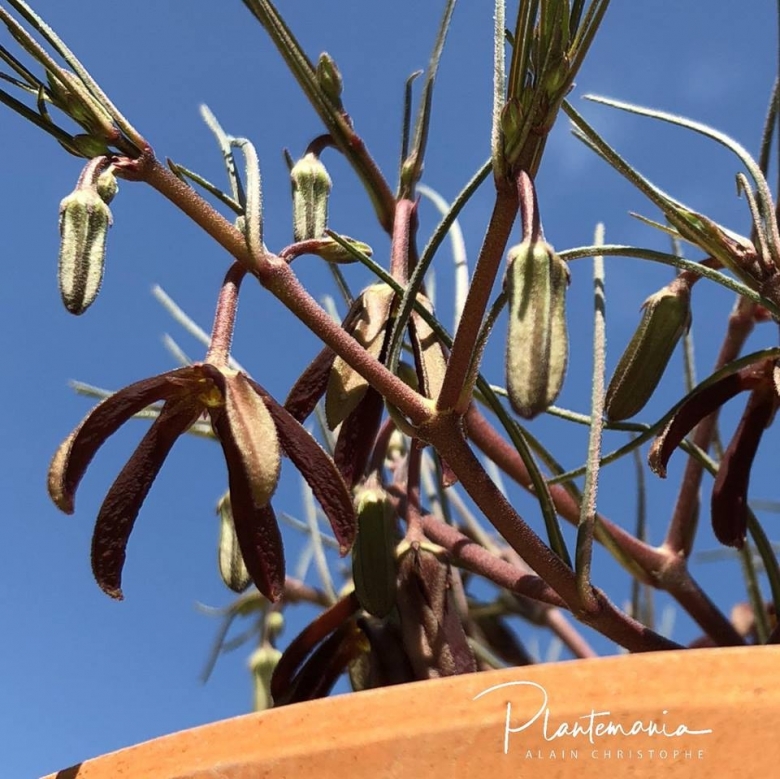
Brachystelma plocamoides Photo by: © Plantemania
Origin and Habitat: Malawi, Tanzania, Zambia, Zimbabwe
Habitat and ecology: Open woodland on compacted bare soil. Brachystelma plocamoidesSN|35252]]SN|35252]] flowers in December.
Synonyms:
See all synonyms of Brachystelma plocamoides
back
Accepted name in llifle Database:Brachystelma plocamoides Oliv.Trans. Linn. Soc. London 29 112 1875.Synonymy: 2
back
Description: Brachystelma plocamoides is a is a dwarf perennial geophyte growing from a large turnip shaped tuber with glabrous, thread like leaves and weeping dividing annual stems. B. plocamoides is similar in habit to Brachystelma lineare, but the leaves are narrower, and the structure of the corona is very different. The intermediate tooth opposed to the anthers being much shorter than the bifid outer segments, reduced to a mere fleshy projection from the inner face of the coronal tube. The segments are confluent into a continuous membranous tube. The rather thin-textured corolla lobes being folded longitudinally are of diagnostic value for B. plocamoides.
Tuber (caudex): Large and fleshy, napiform (turnip shaped), depressed above, 60-120 mm diameter, up to 40 mm high, edible, tasting something like liquorice. The juices is sticky and stains the hands black .
Stem: The stems are produced annually, repeatedly dividing into 2-3 from the base, erect or decumbent-ascending, 7- 25(-40) cm long, glabrous or sparsely hairy.
Leaves: Shortly petiolate, narrowly elliptic to linear, 40-80 mm long, 4-10 mm wide, somewhat erectly divergent, shortly and abruptly uncinate-mucronulate at the apex, glabrous.Midrib thickened below, more or less hairy.
Inflorescence: Sessile, 1(-3) flowered.
Flowers: Extra axillary (between the bases of the leaves), mostly solitary, pedunculate, star shaped, velvety, purple, dark red or orange-grey within and green without. Pedicels10-15 mm long glabrous, occasionally bearing a linear bract at about their middle. Calyx-lobess (sepals) triangular- lanceolate acute, 3-4 mm long, glabrous. Corolla 15-30 (-40) mm in diameter, 5-lobed nearly to the base, outside pale green, glabrous or papillate, wrinkled to pustulate. Corolla tube very short. Lobes spreading, radiating, narrow linear-lanceolatae 7-15(-20) mm long, 2-5 mm broad at their base, slightly ascending, somewhat folded back along the midrib, inside red-brown, basally pale, glabrous. Crown sessile, pale purple, 2 mm long, 5-7 mm in diameter, bowl-like; Outer corona lobes fused basally in 5 contiguous pairs, bifid, longer than the gymnostegium, acute-tipped, intermediate tooth short and succulent; teeth, 31.5-2 mm long, deltoid-acuminate, ascending, glabrous. Inner coronal-lobes scarcely 0.5 mm long, oblong, obtuse, incumbent on the backs of the anthers and shorter than them, dorsally fused to the outer corona, glabrous.
Bibliography: Major references and further lectures
1) Focke Albers, Ulrich Meve “Illustrated Handbook of Succulent Plants: Asclepiadaceae: Asclepiadaceae”, Volume 4 Springer Science & Business Media, 2002
2) Professor Oliver “COL GRANT BOTANY OF THE SPEKE AND GRANT EXPEDITION” Transactions of the Linnean Society of London, Volume 29, page 112, 1875
3) N. E. Brown. “Flora of Tropical Africa”, Vol 4, 1904
4) Binns, B. “A First Check List of the Herbaceous Flora of Malawi” The Government Printer, Zomba, Malawi Page 20. 1968
5) Mapaura, A. & Timberlake, J. (eds) “A checklist of Zimbabwean vascular plants” Southern African Botanical Diversity Network Report No. 33 Sabonet, Pretoria and Harare Page 20. 2004
6) Hyde, M.A., Wursten, B.T., Ballings, P. & Coates Palgrave, M. (2018). "Flora of Zimbabwe: Species information: Brachystelma plocamoides".
https://www.zimbabweflora.co.zw/speciesdata/species.php?species_id=146250, retrieved 24 June 2018











